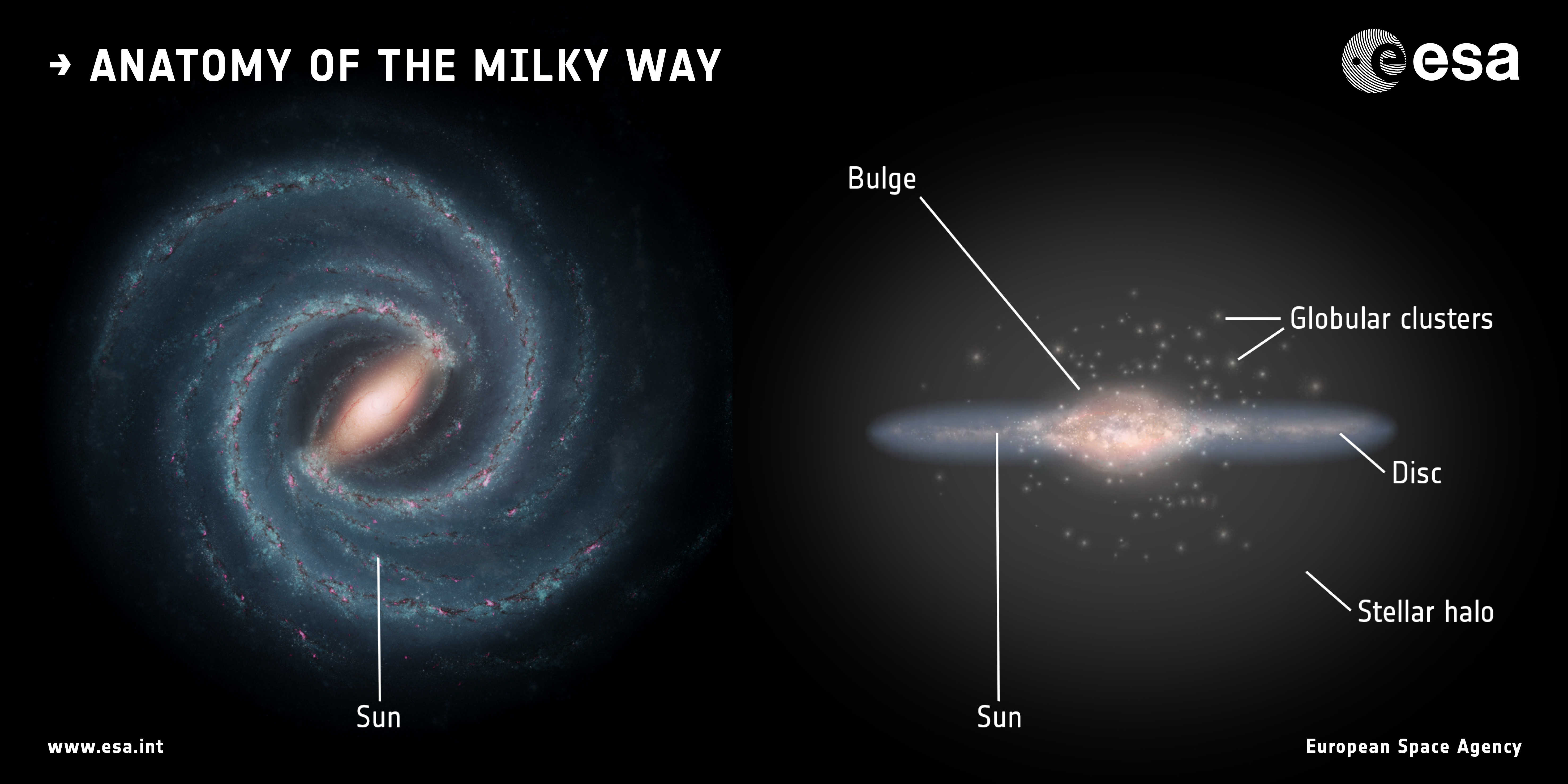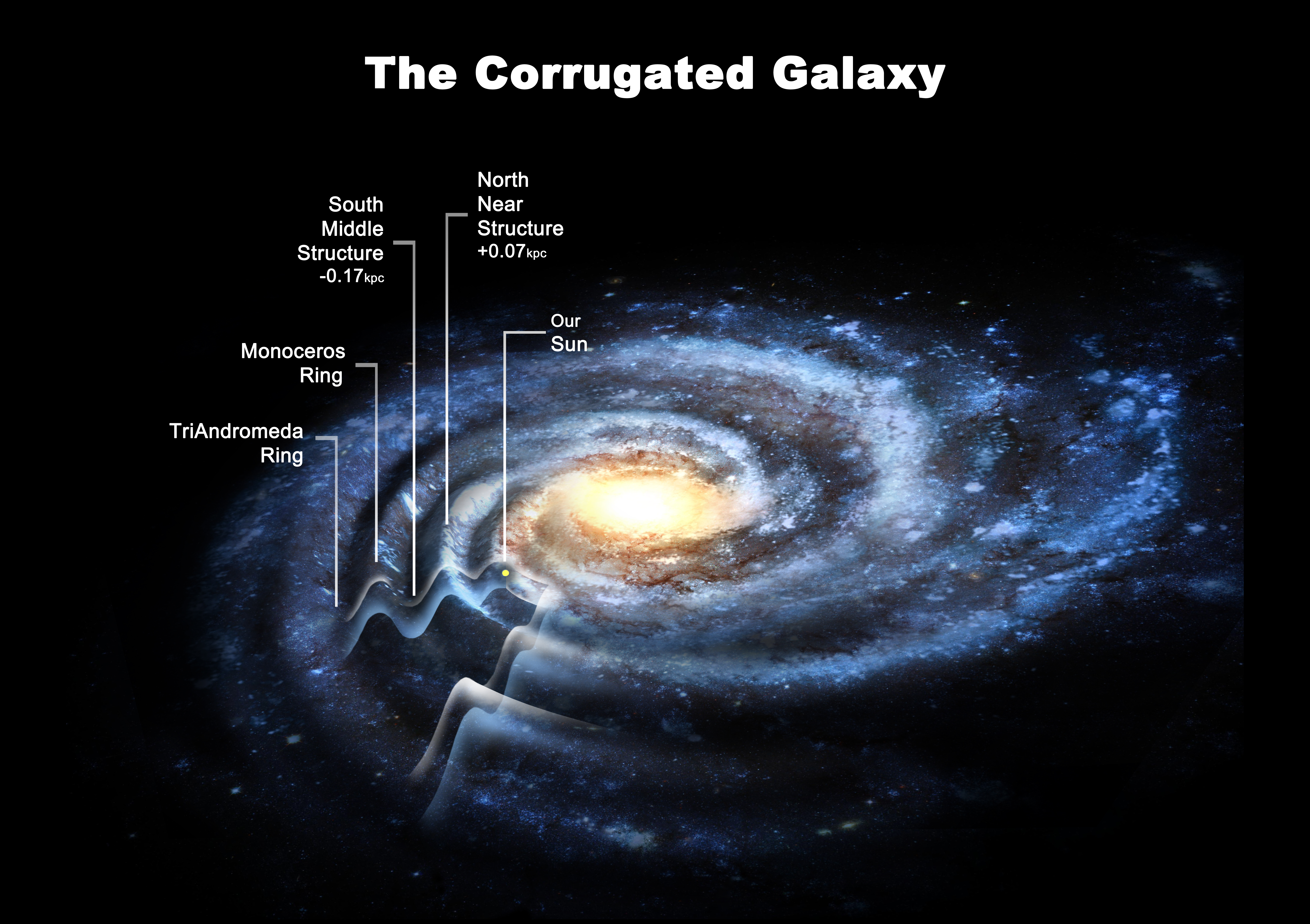Describe the Structure of the Milky Way Galaxy
112 we treat the rotation of the Milky Way its distribution of various kinds of matter and the star populations as well as the phenomenon of the spiral arms. The halo - a roughly spherical distribution which contains the oldest stars in the Galaxy The nuclear bulge and Galactic Center.

Pdf The Bar And Spiral Arms In The Milky Way Structure And Kinematics Semantic Scholar
This is the region of active star formation.

. Here we see the Milky Way Galaxy as it would look from above. Spiral galaxies and other types of galaxies are described in the article galaxy This structure can be viewed as consisting of six separate parts. The annotated artists concept illustrates the new view of the Milky Way.
Galactic nucleus is at the center of galactic disk which possess large number of stars and is in spherical shape. All these elements get bound together by gravitational pull. Galactic nucleus galactic disk and galactic halo.
Milky Way is a galaxy contains stars gas and dust. Explore the Milky Way the disk component of. We begin in Sect.
The Milky Way Galaxys structure is fairly typical of a large spiral system. The Milky Way is the home galaxy of the solar systemIts a barred spiral shape galaxy. The Milky Way is surrounded by several dwarf galaxies typically containing a few tens of millions of stars.
Explore the Milky Way the disk component of our galaxy and the halo central bulge and. The milky way is a large spiral galaxy whose disk is about 100000 light-years wide and about 10000 light-years thick at the nucleus and the structure has at. 111 with the information about the structure of the Milky Way which can be gained from observations of the distribution and motions of the stars within it.
On the left a face-on view shows the spiral structure of the Galactic Disc where the majority of stars are located interspersed with a diffuse mixture of gas and cosmic dust. The Sun is located in the Orion Arm. The Milky Way Galaxy is thought to have a barred spiral structure that is intermediate between these two examples.
Milky Way Galaxy the spiral galaxy in which the Sun resides. All the stars we see in the night sky are in our own Milky Way Galaxy. The structure of our galaxy known as the Milky Way galaxy includes stars gas dust and nebulae.
The label below the picture reads Rotation of cloud of gas and dust The picture shows an elliptical orbit with a planet on it. In a galaxy which has a spiral shape the gases dust and stars are organized in such a way that they form a bulge or a disk in the center with spiral arms surrounding it. Our Sun lies within the Orion Arm about 26000 light years from the center.
1 a nucleus 2 a central bulge 3 a disk both a thin and a thick disk 4 spiral arms 5 a spherical component and 6 a massive halo. Modification of work by ESOPESSTOS. A circle above the cloud shows that the cloud and dust are rotating in the anticlockwise direction.
Structure of the Milky Way The Milky Way can be broken into four structural components. View the full answer Previous question Next question. Previously our galaxy was thought to possess four major arms.
Galactic halo consists of 150 globular clusters which are outside galactic disk. Accordingly the galaxy from the Greek word gala. Milk is a bent wheel 100000 light years in diameter and with a thickness of just 5000 light years.
At the center of the orbit there is a circular sun. The disk of our Galaxy is visible in the night sky as the faint band of light known as the Milky Way Galactic disk flattened region of gas and dust that bisects the galactic halo in a spiral galaxy. Our Sun a star and all the planets around it are part of a galaxy known as the Milky Way Galaxy.
A galaxy is a large group of stars gas and dust bound together by gravity. Bulge disk stellar normal halo non-baryonic dark matter halo. Using infrared images from NASAs Spitzer Space Telescope scientists have discovered that the Milky Ways elegant spiral structure is dominated by just two arms wrapping off the ends of a central bar of stars.
Modification of work by ESO. An artists impression of our Milky Way galaxy a roughly 13 billon-year-old barred spiral galaxy that is home to a few hundred billion stars. They come in a variety of shapes and sizes.
The shape of the milky way is spiral. The Milky Way galaxy is a spiral galaxy of about 200000000000 stars. Two spiral arms Scutum-Centaurus and Perseus emerge from the ends of the bar and wrap around the bulge.
The Arms of the Milky Way Our radio observations of the disks gaseous component indicate that the Galaxy has two major spiral arms that emerge from the bar and several fainter arms and shorter spurs. You can see a recently assembled map of our Galaxys arm structurederived from studies in the infraredin Figure 1. Milky Way has 3 different parts.
The Structure of the Milky Way The Milky Way Galaxy The Milky Way system is a spiral galaxy consisting of over 400 billion stars plus gas and dust arranged into three general components as shown to the left. Thus the structure of the milky way is best described by the statement - a core with spiral arms. Bulge - center of the galaxy Galactic center where globular clusters are distributed throughout Disk - thin disk around the bulge Halo - spherical distribution of stars surrounding the galaxy Spiral arms What is the average size Average size spiral galaxy Made of gas dust and stars Over 400 billion stars 2 Views of the Milky Way.
Galaxies varies in size from 10000 to 200000 light yea. The Milky Way is a large barred spiral galaxy. This image assembled from data from NASAs Spitzer mission shows that the Milky Way Galaxy has a modest bar in its central regions.
The structure of our galaxy known as the Milky Way galaxy includes stars gas dust and nebulae.

Astronomy Ch 28 The Milky Way 1 Of 27 The General Structure Youtube

Comments
Post a Comment